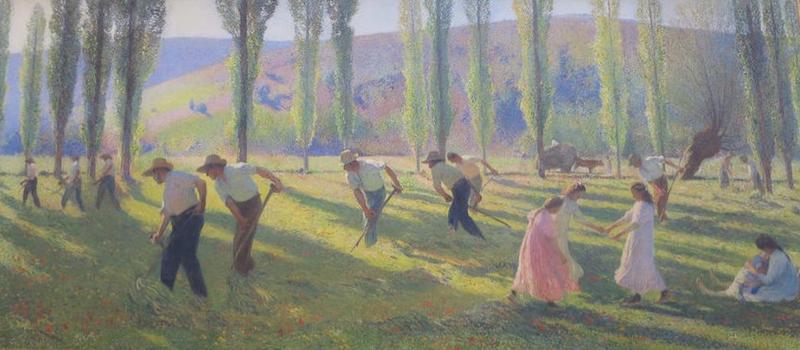Les Fauchers

Light had filled Martin’s canvasses following a scholarship from the Salon to study in Italy and he had moved away from historical and biblical subjects painted in a precise academic tradition to light-filled, dream-like, often symbolist, tranquil canvases painted en plein air, merging an impressionist and pointillist technique with idyllic interpretations of the landscape.
Although an easel painter throughout his life, it was as a decorative artist that Martin made his name. He mixed allegory with depictions of joyful nature often shrouded in a hazy glow and Puvis de Chavannes saw him as his natural successor. He was the recipient of several state commissioned projects, including the most celebrated triptych for the Capitole of Toulouse in 1903. This was a monumental composition often described as “Spring, Summer and Autumn” or simply Les Faucheurs (‘The Reapers’). This elegant, dream-like painting is the final preparatory oil for the centrepiece of the Toulouse triptych.
Martin adopted a pointillist technique to create a synthesis of both the separate application of pure colour with the blended brushwork of the Impressionists. He depicts a timeless bucolic scene which he gives a classical, idealised treatment. The workers in the fields work in time and harmony with each other and with nature. Their rhythm of movement is also the rhythm of the seasons. The circular direction of the scythes mimics the circle of girls dancing in a ring to the side. A mother sits nursing her child on the edge of the canvas, symbolising the cyclical re-birth of nature and man being part of that nature. (A scene that he again depicts in his painting for ‘Agriculture’ in his monumental murals in the Conseil d’Etat, in the Palais Royal, Paris.) The panorama is brought together by a glorious soft palette of pinks and purples (not colours generally associated with the tones of the earth), thus, imbuing the scene with an ethereal light. There is a sense of psychological and physical balance in the painting which is depicted in three plains with the groups of figures placed on the front plain. The middle plain is demarcated by thirteen main poplars which link with the thirteen main figures, creating a harmony of design, enhanced by the long shadows of the trees which create strong diagonals across the canvas. All the figures’ heads are facing downwards towards the earth and they are completely involved in their actions. The third plain can be seen through the golden lit poplars and depicts a hillside infused with a pink and purple, hazy, supernal light.
A shy, quiet character, Henri Martin remained independent, refusing to be contracted to one particular Parisian dealer, despite the success garnered by many of his contemporaries by such arrangements. He won praise and medals at the Paris Salon and became a member of the Legion of Honour. In 1900 he bought Marquayrol, an old farmhouse near Labastide-du-Vert in the Lot Valley. The house, his family and the beautiful landscape provided him with inspiration for the rest of his life. Martin sought to convey the colours and textures of the changing seasons and the ancient rhythm of the agricultural world.



